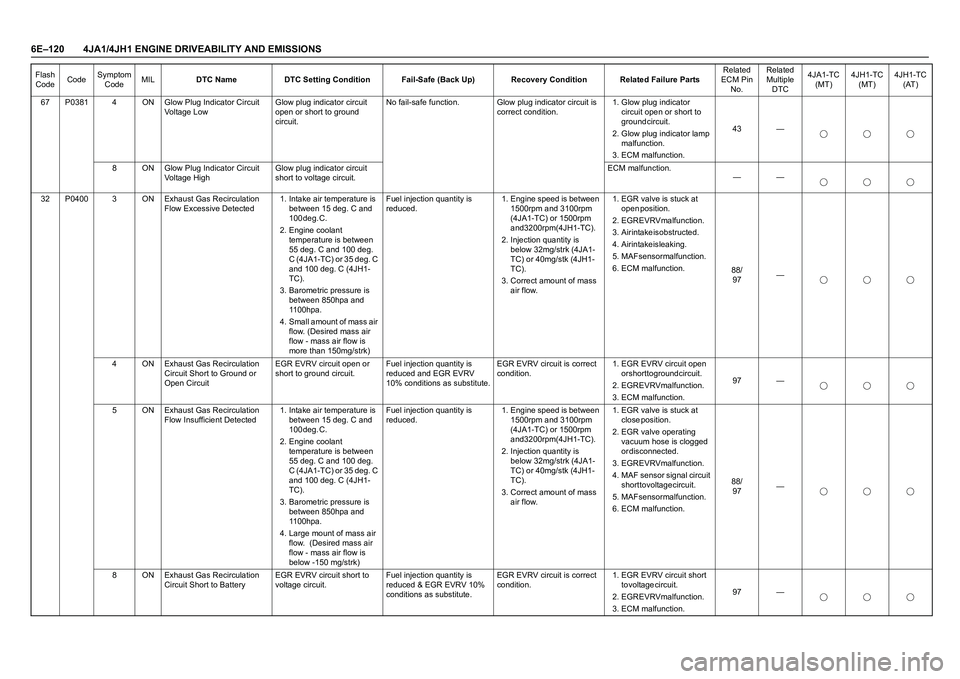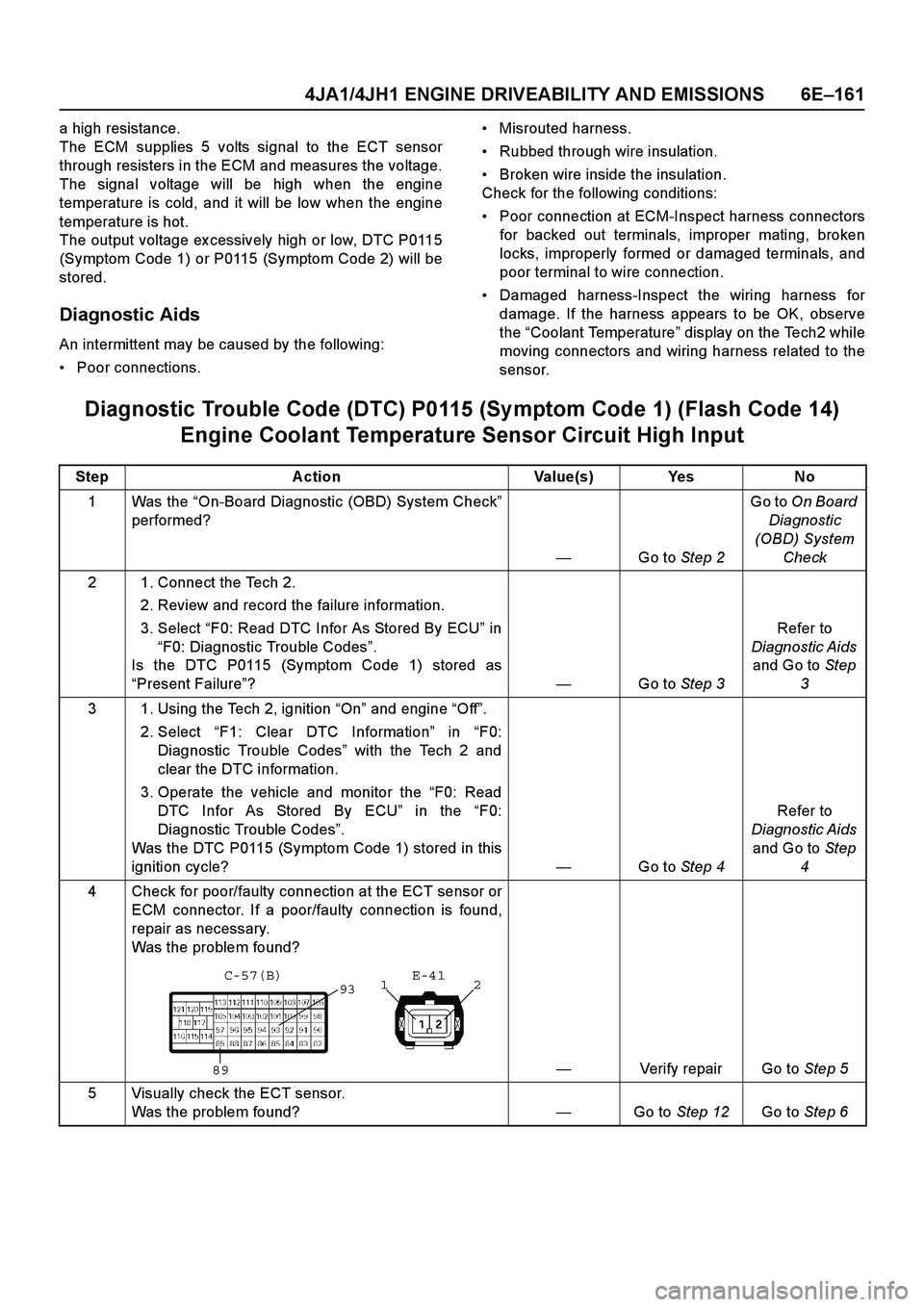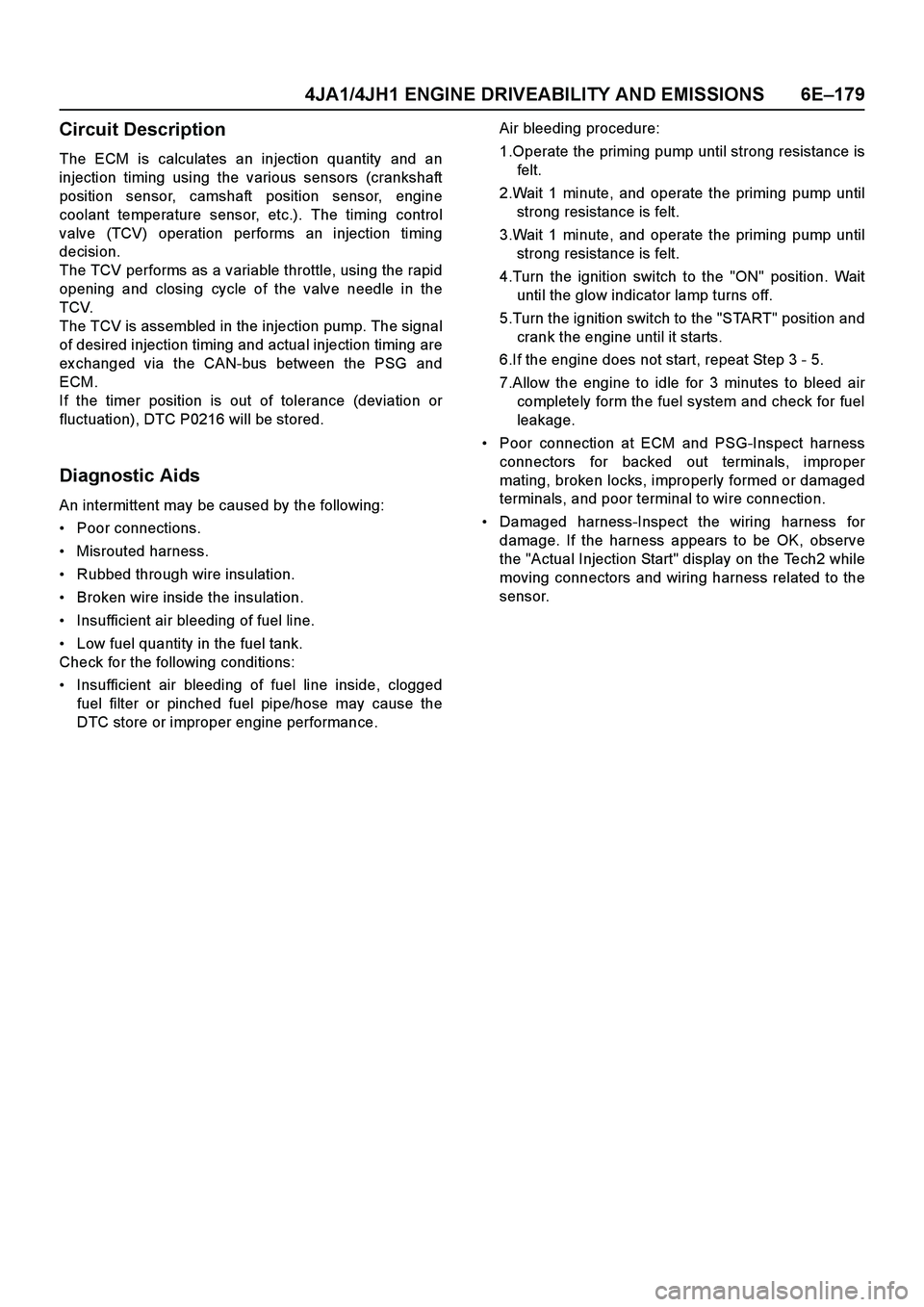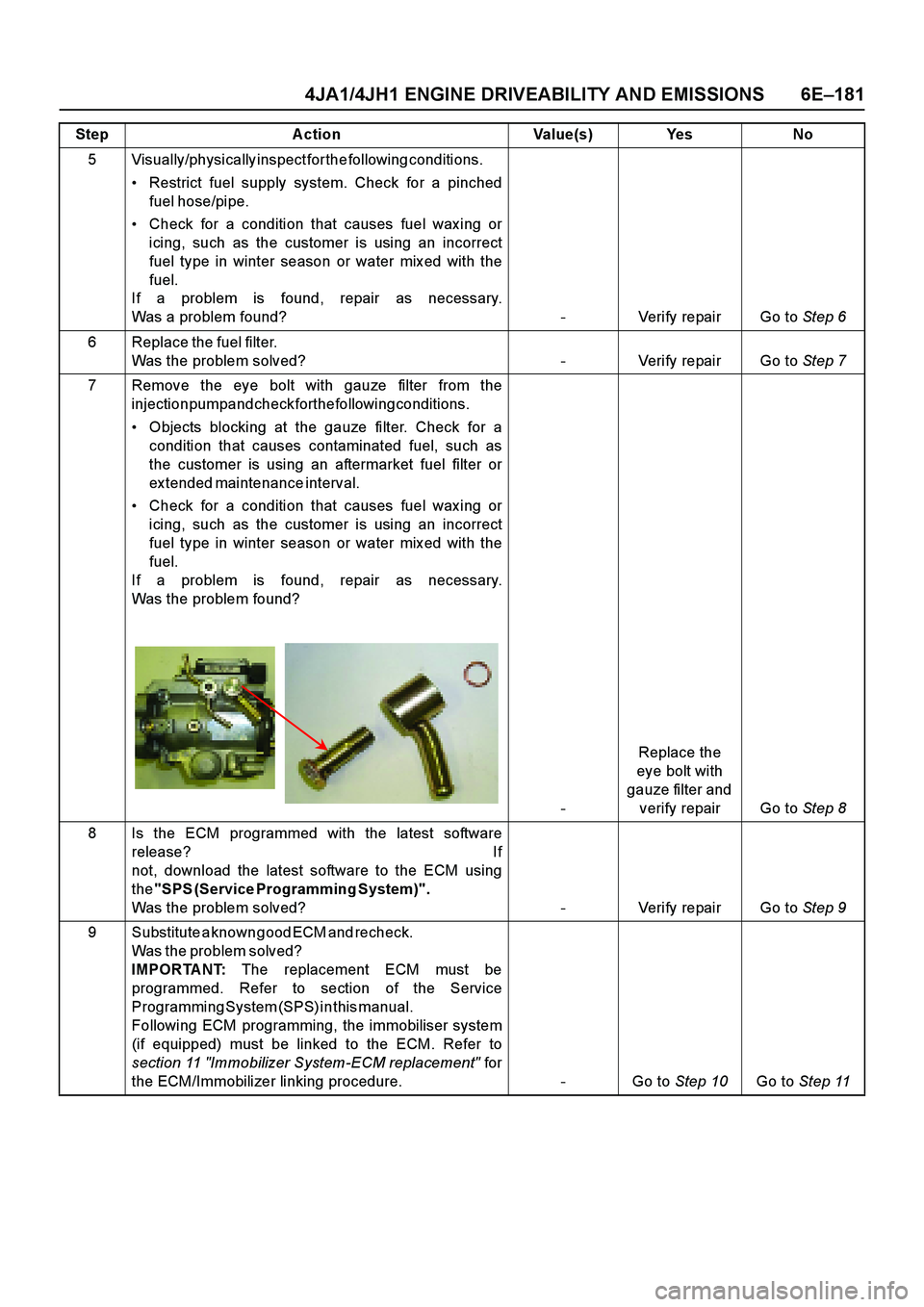2004 ISUZU TF SERIES air condition
[x] Cancel search: air conditionPage 1492 of 4264

6E–120 4JA1/4JH1 ENGINE DRIVEABILITY AND EMISSIONS
67 P0381 4 ON Glow Plug Indicator Circuit
Voltage LowGlow plug indicator circuit
open or short to ground
circuit.No fail-safe function. Glow plug indicator circuit is
correct condition.1. Glow plug indicator
circuit open or short to
g r o u n d c i r c u i t .
2. Glow plug indicator lamp
m a l f u n c t i o n .
3. ECM malfunction.43 —
8 ON Glow Plug Indicator Circuit
Voltage HighGlow plug indicator circuit
short to voltage circuit.ECM malfunction.
——
32 P0400 3 ON Exhaust Gas Recirculation
Flow Excessive Detected1. Intake air temperature is
between 15 deg. C and
1 0 0 d e g . C .
2. Engine coolant
temperature is between
55 deg. C and 100 deg.
C (4JA1-TC) or 35 deg. C
and 100 deg. C (4JH1-
T C ) .
3. Barometric pressure is
between 850hpa and
1 1 0 0 h p a .
4. Small amount of mass air
flow. (Desired mass air
flow - mass air flow is
more than 150mg/strk)Fuel injection quantity is
reduced. 1. Engine speed is between
1500rpm and 3100rpm
(4JA1-TC) or 1500rpm
and 3200rpm (4JH1-TC).
2. Injection quantity is
below 32mg/strk (4JA1-
TC) or 40mg/stk (4JH1-
T C ) .
3. Correct amount of mass
air flow.1. EGR valve is stuck at
o p e n p o s i t i o n .
2. EGR EVRV malfunction.
3 . A i r i n t a k e i s o b s t r u c t e d .
4. Air intake is leaking.
5. MAF sensor malfunction.
6. ECM malfunction.
8 8 /
97—
4 ON Exhaust Gas Recirculation
Circuit Short to Ground or
Open CircuitEGR EVRV circuit open or
short to ground circuit.Fuel injection quantity is
reduced and EGR EVRV
10% conditions as substitute.EGR EVRV circuit is correct
condition.1. EGR EVRV circuit open
or short to ground circuit.
2. EGR EVRV malfunction.
3. ECM malfunction.97 —
5 ON Exhaust Gas Recirculation
Flow Insufficient Detected1. Intake air temperature is
between 15 deg. C and
100 deg. C.
2. Engine coolant
temperature is between
55 deg. C and 100 deg.
C (4JA1-TC) or 35 deg. C
and 100 deg. C (4JH1-
T C ) .
3. Barometric pressure is
between 850hpa and
1 1 0 0 h p a .
4. Large mount of mass air
flow. (Desired mass air
flow - mass air flow is
below -150 mg/strk)Fuel injection quantity is
reduced. 1. Engine speed is between
1500rpm and 3100rpm
(4JA1-TC) or 1500rpm
and 3200rpm (4JH1-TC).
2. Injection quantity is
below 32mg/strk (4JA1-
TC) or 40mg/stk (4JH1-
T C ) .
3. Correct amount of mass
air flow.1. EGR valve is stuck at
c l o s e p o s i t i o n .
2. EGR valve operating
vacuum hose is clogged
or disconnected.
3. EGR EVRV malfunction.
4. MAF sensor signal circuit
short to voltage circuit.
5. MAF sensor malfunction.
6. ECM malfunction.8 8 /
97—
8 ON Exhaust Gas Recirculation
Circuit Short to BatteryEGR EVRV circuit short to
voltage circuit.Fuel injection quantity is
reduced & EGR EVRV 10%
conditions as substitute.EGR EVRV circuit is correct
condition.1. EGR EVRV circuit short
t o v o l t a g e c i r c u i t .
2. EGR EVRV malfunction.
3. ECM malfunction.97 — Flash
CodeCodeSymptom
CodeMILDTC Name DTC Setting Condition Fail-Safe (Back Up) Recovery Condition Related Failure PartsRelated
ECM Pin
No.Related
Multiple
DTC4JA1-TC
(MT)4JH1-TC
(MT)4JH1-TC
(AT)
Page 1501 of 4264

4JA1/4JH1 ENGINE DRIVEABILITY AND EMISSIONS 6E–129
Condition for setting the DTC and action taken when the DTC sets
Circuit Description
The mass air flow (MAF) sensor is part of the intake air
system. It is fitted between the air cleaner and
turbocharger and measure the mass air flowing into the
engine.
The mass air flow (MAF) sensor element measures the
partial air mass through a measurement duct on the
sensor housing.
The ECM monitors the MAF sensor supply voltage and
MAF sensor output voltage. The supply voltage is out of
range, DTC P0100 (Symptom Code 7) or P0100
(Symptom Code 9) will be stored. The output voltage
ex cessively high or low, DTC P0100 (Symptom Code B)
or P0100 (Symptom Code C) will be stored.
Diagnostic Aids
An intermittent may be caused by the following:
Poor connections.
Misrouted harness.
Rubbed through wire insulation.
Broken wire inside the insulation.
Check for the following conditions:
Poor connection at ECM-Inspect harness connectors
for backed out terminals, improper mating, broken
locks, improperly formed or damaged terminals, and
poor terminal to wire connection.
Damaged harness-Inspect the wiring harness for
damage. If the harness appears to be OK, observe
the “Mass Air Flow” display on the Tech2 while
moving connectors and wiring harness related to the
sensor.
Diagnostic Trouble Code (DTC) P0100 (Symptom Code 7) (Flash Code 65)
Mass Air Flow (MAF) Sensor Voltage Supply Circuit High Input
Flash
CodeCodeSymptom
CodeMIL DTC Name DTC Setting Condition Fail-Safe (Back Up)
65 P0100 7 ON Ma ss Air Flo w (MAF) Senso r
Voltage Supply Circuit High
InputMAF sensor power supply
voltage is more than 5.2V.ECM uses ma ss a ir flo w
1600mg/strk & EGR 10% co n-
ditions as substitute.
9 ON Mass Air Flow (MAF) Sensor
Voltage Supply Circuit Low
InputMAF sensor power supply
voltage is below 4.6V.
B ON Mass Air Flow (MAF) Sensor
Output Circuit Low Input1. Engine speed is between
600rpm and 5000rpm.
2. MAF se nsor o utput is
below -33.7mg/strk.
C ON Mass Air Flow (MAF) Sensor
Output Circuit High Input1. Engine speed is between
600rpm and 5000rpm.
2. MAF sensor output is more
tha n 1378mg/strk (4JA1-TC)
o r 1784mg/strk (4JH1-TC).
Step Action Value(s) Yes No
1Was the “On-Board Diagnostic (OBD) System Check”
performed?
—Go to Step 2Go to On Board
Diagnostic
(OBD) System
Check
2 1. Connect the Tech 2.
2. Review and record the failure information.
3. Select “F0: Read DTC Infor As Stored By ECU” in
“F0: Diagnostic Trouble Codes”.
Is the DTC P0100 (Symptom Code 7) stored as
“Present Failure”?—Go to Step 3Refer to
Diagnostic Aids
and Go to Step
3
Page 1524 of 4264

6E–152 4JA1/4JH1 ENGINE DRIVEABILITY AND EMISSIONS
DIAGNOSTIC TROUBLE CODE (DTC) P0110 (SYMPTOM CODE 1)
(FLASH CODE 23) INTAKE AIR TEMPERATURE (IAT) SENSOR CIRCUIT HIGH
INPUT
DIAGNOSTIC TROUBLE CODE (DTC) P0110 (SYMPTOM CODE 2)
(FLASH CODE 23) INTAKE AIR TEMPERATURE (IAT) SENSOR CIRCUIT LOW
INPUT
Condition for setting the DTC and action taken when the DTC sets
Circuit Description
The IAT sensor is a thermistor. A temperature changesthe resistance value. And it changes voltage. In other
words it measures a temperature value. Low air
temperature produces a high resistance.
Flash
CodeCode Symptom
CodeMIL DTC Name DTC Setting Condition Fail-Safe (Back Up)
23 P0110 1 ON Intake Air Temperature (IAT)
Se nsor Circuit High InputIAT sensor output voltage is
more than 4.7V.ECM use deg.C conditions as
substitute.
2 ON Intake Air Temperature (IAT)
Se nsor Circuit Low InputIAT sensor output voltage is
be lo w 0.3V.
Page 1525 of 4264

4JA1/4JH1 ENGINE DRIVEABILITY AND EMISSIONS 6E –153
The ECM supplies 5 volts signal to the IAT sensor
through resisters in the ECM and measures the voltage.
The signal voltage will be high when the air temperature
is cold, and it will be low when the air temperature is
hot.
The output voltage ex cessively high or low, DTC P0110
(Symptom Code 1) or P0110 (Symptom Code 2) will be
stored.
Diagnostic Aids
An intermittent may be caused by the following:
Poor connections.
Misrouted harness.
Rubbed through wire insulation.
Broken wire inside the insulation.
Check for the following conditions:
Poor connection at ECM-Inspect harness connectors
for backed out terminals, improper mating, broken
locks, improperly formed or damaged terminals, and
poor terminal to wire connection.
Damaged harness-Inspect the wiring harness for
damage. If the harness appears to be OK, observe
the “Intake Air Temperature ” display on the Tech2
while moving connectors and wiring harness related
to the sensor.
Diagnostic Trouble Code (DTC) P0110 (Sy mptom Code 1) (Flash Code 23)
Intake Air Temperature (IAT) Sensor Circuit High Input
Step Action Value(s) Yes No
1Was the “On-Board Diagnostic (OBD) System Check ”
performed?
— Go to Step 2 Go to
On Board
Diagnostic
(OBD) System Check
2 1. Connect the Tech 2. 2. Review and record the failure information.
3. Select “F0: Read DTC Infor As Stored By ECU ” in
“ F0: Diagnostic Trouble Codes ”.
Is the DTC P0110 (Symptom Code 1) stored as
“ Present Failure ”? —Go to Step 3 Refer to
Diagnostic Aids and Go to Step
3
3 1. Using the Tech 2, ignition “On ” and engine “Off ”.
2. Select “F1: Clear DTC Information ” in “F0:
Diagnostic Trouble Codes ” with the Tech 2 and
clear the DTC information.
3. Operate the vehicle and monitor the “F0: Read
DTC Infor As Stored By ECU ” in the “F0:
Diagnostic Trouble Codes ”.
Was the DTC P0110 (Symptom Code 1) stored in this
ignition cycle? —Go to Step 4 Refer to
Diagnostic Aids and Go to Step
4
4 Check for poor/faulty connection at the IAT sensor or ECM connector. If a poor/faulty connection is found,
repair as necessary.
Was the problem found?
— Verify repair Go to Step 5
5 Visually check the IAT sensor. Was the problem found? —Go to Step 12 Go to Step 6
92
84
1 3
C-116
C-57(B)
Page 1533 of 4264

4JA1/4JH1 ENGINE DRIVEABILITY AND EMISSIONS 6E –161
a high resistance.
The ECM supplies 5 volts signal to the ECT sensor
through resisters in the ECM and measures the voltage.
The signal voltage will be high when the engine
temperature is cold, and it will be low when the engine
temperature is hot.
The output voltage ex cessively high or low, DTC P0115
(Symptom Code 1) or P0115 (Symptom Code 2) will be
stored.
Diagnostic Aids
An intermittent may be caused by the following:
Poor connections.
Misrouted harness.
Rubbed through wire insulation.
Broken wire inside the insulation.
Check for the following conditions:
Poor connection at ECM-Inspect harness connectors
for backed out terminals, improper mating, broken
locks, improperly formed or damaged terminals, and
poor terminal to wire connection.
Damaged harness-Inspect the wiring harness for
damage. If the harness appears to be OK, observe
the “Coolant Temperature ” display on the Tech2 while
moving connectors and wiring harness related to the
sensor.
Diagnostic Trouble Code (DTC) P0115 (Sy mptom Code 1) (Flash Code 14)
Engine Coolant Temperature Sensor Circuit High Input
Step Action Value(s) Yes No
1Was the “On-Board Diagnostic (OBD) System Check ”
performed?
— Go to Step 2 Go to
On Board
Diagnostic
(OBD) System Check
2 1. Connect the Tech 2. 2. Review and record the failure information.
3. Select “F0: Read DTC Infor As Stored By ECU ” in
“ F0: Diagnostic Trouble Codes ”.
Is the DTC P0115 (Symptom Code 1) stored as
“ Present Failure ”? —Go to Step 3 Refer to
Diagnostic Aids and Go to Step
3
3 1. Using the Tech 2, ignition “On ” and engine “Off ”.
2. Select “F1: Clear DTC Information ” in “F0:
Diagnostic Trouble Codes ” with the Tech 2 and
clear the DTC information.
3. Operate the vehicle and monitor the “F0: Read
DTC Infor As Stored By ECU ” in the “F0:
Diagnostic Trouble Codes ”.
Was the DTC P0115 (Symptom Code 1) stored in this
ignition cycle? —Go to Step 4 Refer to
Diagnostic Aids and Go to Step
4
4 Check for poor/faulty connection at the ECT sensor or ECM connector. If a poor/faulty connection is found,
repair as necessary.
Was the problem found?
— Verify repair Go to Step 5
5 Visually check the ECT sensor. Was the problem found? —Go to Step 12 Go to Step 6
932
1
89 E-41
C-57(B)
Page 1551 of 4264

4JA1/4JH1 ENGINE DRIVEABILITY AND EMISSIONS 6E–179
Circuit Description
The ECM is calculates an injection quantity and an
injection timing using the various sensors (crankshaft
position sensor, camshaft position sensor, engine
coolant temperature sensor, etc.). The timing control
valve (TCV) operation performs an injection timing
decision.
The TCV performs as a variable throttle, using the rapid
opening and closing cycle of the valve needle in the
TCV.
The TCV is assembled in the injection pump. The signal
of desired injection timing and actual injection timing are
ex changed via the CAN-bus between the PSG and
ECM.
If the timer position is out of tolerance (deviation or
fluctuation), DTC P0216 will be stored.
Diagnostic Aids
An intermittent may be caused by the following:
Poor connections.
Misrouted harness.
Rubbed through wire insulation.
Broken wire inside the insulation.
Insufficient air bleeding of fuel line.
Low fuel quantity in the fuel tank.
Check for the following conditions:
Insufficient air bleeding of fuel line inside, clogged
fuel filter or pinched fuel pipe/hose may cause the
DTC store or improper engine performance.Air bleeding procedure:
1.Operate the priming pump until strong resistance is
felt.
2.Wait 1 minute, and operate the priming pump until
strong resistance is felt.
3.Wait 1 minute, and operate the priming pump until
strong resistance is felt.
4.Turn the ignition switch to the "ON" position. Wait
until the glow indicator lamp turns off.
5.Turn the ignition switch to the "START" position and
crank the engine until it starts.
6.If the engine does not start, repeat Step 3 - 5.
7.Allow the engine to idle for 3 minutes to bleed air
completely form the fuel system and check for fuel
leakage.
Poor connection at ECM and PSG-Inspect harness
connectors for backed out terminals, improper
mating, broken locks, improperly formed or damaged
terminals, and poor terminal to wire connection.
Damaged harness-Inspect the wiring harness for
damage. If the harness appears to be OK, observe
the "Actual Injection Start" display on the Tech2 while
moving connectors and wiring harness related to the
sensor.
Page 1553 of 4264

4JA1/4JH1 ENGINE DRIVEABILITY AND EMISSIONS 6E–181
5 V i s u a l l y / p h y s i c a l l y i n s p e c t f o r t h e f o l l o w i n g c o n d i t i o n s .
Restrict fuel supply system. Check for a pinched
fuel ho se /pi pe.
Check for a condition that causes fuel wax ing or
icing, such as the customer is using an incorrect
fuel type in winter season or water mix ed with the
f u e l.
If a problem is found, repair as necessary.
Was a problem found? - Verify repair Go to Step 6
6 Replace the fuel fi lt er.
Was the problem solved? - Verify repair Go to Step 7
7 Remove the eye bolt with gauze filter from the
injection pump and check for the following conditions.
Objects blocking at the gauze filter. Check for a
condition that causes contaminated fuel, such as
the customer is using an aftermarket fuel filter or
ex tended maintenance interval.
Check for a condition that causes fuel wax ing or
icing, such as the customer is using an incorrect
fuel type in winter season or water mix ed with the
f u e l.
If a problem is found, repair as necessary.
Was the problem found?
-Replace the
eye bolt with
gauze filter and
verify repair Go to Step 8
8 Is the ECM programmed with the latest software
release? If
not, download the latest software to the ECM using
the "SPS (Service Programming System)".
Was the problem solved? - Verify repair Go to Step 9
9 Substitute a known good ECM and recheck.
Was the problem solved?
IMPORTANT: The replacement ECM must be
programmed. Refer to section of the Service
Programming System (SPS) in this manual.
Following ECM programming, the immobiliser system
(if equipped) must be linked to the ECM. Refer to
section 11 "Immobilizer System-ECM replacement" for
the ECM/Immobilizer linking procedure. - Go to Step 10Go to Step 11 Step Action Value(s) Yes No
Page 1556 of 4264

6E–184 4JA1/4JH1 ENGINE DRIVEABILITY AND EMISSIONS
Condition for setting the DTC and action taken when the DTC sets
Circuit description
The ECM monitors altitude from the barometric
pressure sensor. To apply specified vacuum pressure to
the turbocharger wastegate valve, ECM sends control
signal to the wastegate control solenoid depending on
altitude.
Then, apply vacuum pressure to the turbocharger
wastegate valve is monitored by the ECM form the
vacuum pressure sensor output signal. The ECM
controls wastegate control solenoid based on signal
from vacuum pressure sensor output.
If the vacuum pressure sensor detected vacuum
pressure is excessively low or high due to faulty vacuum
line, vacuum pump or turbocharger wastegate valve,
DTC P0243 (Symptom Code 3), P0243 (Symptom Code
5) or P0243 (Symptom Code 6) will be stored.
If the wastegate control solenoid circuit is open or short
to ground circuit, DTC P0243 (Symptom Code 4) will be
stored.
If the wastegate control solenoid circuit is short to
voltage circuit, DTC P0243 (Symptom Code 8) will be
stored.
Diagnostic Aids
An intermittent may be caused by the following:
Poor connections.
Misrouted harness.
Rubbed through wire insulation.
Broken wire inside insulation.
Turbocharger wastegate valve sticking or broken.
Misrouted vacuum hose.
Faulty vacuum pump or regulating valve.
Check for the following conditions:
Poor connection at ECM-Inspect harness connectors
for backed out terminals, improper mating, broken
locks, improperly formed or damaged terminals, and
poor terminal to wire connection.
Damaged harness-Inspect the wiring harness for
damage. If the harness appears to be OK, observe
the DTC P0243 display on the Tech 2 while moving
connectors and wiring harnesses. A change in the
display will indicate the location of the fault.
Flash
CodeCode Symptom
CodeMIL DTC Name DTC Setting Condition Fail-Safe (Back Up)
64 P0243 3 ON Turbocharger Wastegate
So le no id "A" Ra nge/
Pe rfo rma nce1. Intake air temperature is
between -50 deg. C and
2 0 0 d e g . C .
2. Engine coolant
temperature is between -
50 deg. C and 150 deg.
C. 1. Fuel injection quantity is
r e d u c e d .
2. EGR EVRV becomes 10%
co nditio n.
4 ON Turbocharger Wastegate
So le no id "A" Lo w Wastegate control EVRV
circuit open or short to ground
circuit.1. Fuel injection quantity is
r e d u c e d .
2. EGR EVRV becomes 10%
c o n d i t i o n .
3. Wastegate control EVRV
be co mes 32% conditio n.
5 ON Turbocharger Wastegate
So le no id "A" Ra nge/
Pe rfo rma nce1. Intake air temperature is
between -50 deg. C and
2 0 0 d e g . C .
2. Engine coolant
temperature is between -
50 deg. C and 150 deg.
C. 1. Fuel injection quantity is
r e d u c e d .
2. EGR EVRV becomes 10%
co nditio n.
6 ON Turbocharger Wastegate
So le no id "A" Malfunctio n1. Engine coolant
temperature is between -
50 deg. C and 150 deg.
C .
2. EGR contro l EVRV 0%
co nditio n.
8 ON Turbocharger Wastegate
So le no id "A" HighWastegate control EVRV
circuit short to voltage circuit.1. Fuel injection quantity is
r e d u c e d .
2. EGR EVRV becomes 10%
c o n d i t i o n .
3. Wastegate control EVRV
be co mes 32% conditio n.